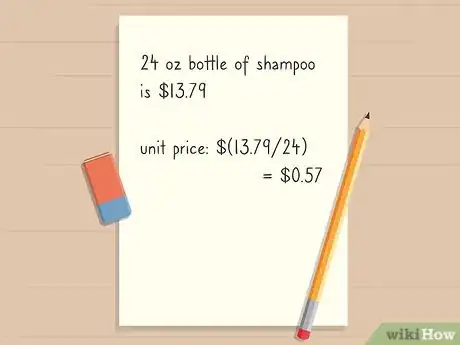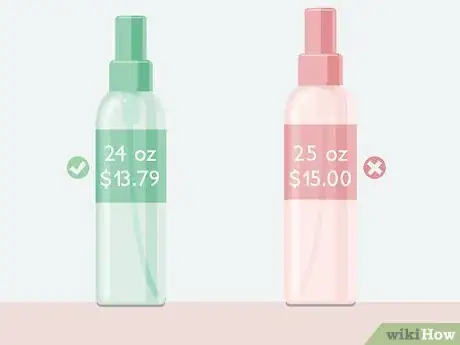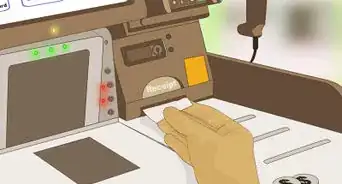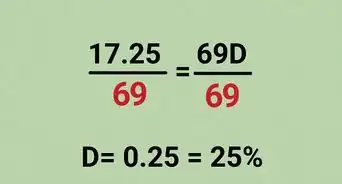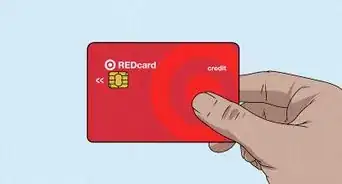This article was co-authored by wikiHow staff writer, Danielle Blinka, MA, MPA. Danielle Blinka is a Writer, Editor, Podcaster, Improv Performer, and Artist currently living in Houston, TX. She also has experience teaching English and writing to others. Danielle holds a Bachelor of Arts in English, Bachelor of Arts in Political Science, Master of Arts in English with a concentration in writing, and Master of Public Administration from Lamar University.
This article has been viewed 408,707 times.
Learn more...
Sometimes it’s hard to tell if a bigger package is really a better value when you’re shopping for items at a store. Fortunately, checking the item’s unit price can help you figure out which package provides the most product for the cost. The unit price is the cost per quantity of item you’re receiving. The quantity might be per item or per unit of measurement, such as ounces, grams, gallons, or liters. To calculate the unit price, simply divide the cost of the product by the quantity you’re receiving or check the store’s shelf label. Then, compare the unit prices of 2 or more packages of the same product to see which is the better value.
Steps
Calculating Unit Price
-
1Check the item’s total price. The unit price is typically a fraction of the total cost of the product. Look at the price tag or use a price scanning tool to find the total price of the product.[1]
- If you have a coupon, subtract the coupon value from the total price before you calculate the unit price.
-
2Find the quantity of the item that the package contains. Look on the label to check the amount of product in the container. The quantity is normally listed on the bottom right corner of the package.[2]
- Some products will be sold by item, such as toilet paper, paper towels, or pencils. However, most items will have a unit of measurement, like ounces, cups, quarts, gallons, milliliters, liters, etc.
Tip: If the product is priced by item or unit, then the unit price will be the cost of the item. For instance, if you’re looking at watermelons that are $3.98 per melon, then the unit price is $3.98. Similarly, if you were purchasing a single roll of paper towels for $1.50, that’s the unit price.
Advertisement -
3Make sure both products have the same unit of measurement. Sometimes the products you’re comparing measure their quantity using different units, such as quarts versus gallons or ounces versus grams. If this is the case, change the unit of measurement for one of the products to match the other before you calculate the unit rate.[3]
- For example, let’s say you’re looking at a quart of milk for $1.25 and a gallon of milk for $4.29. There are 4 quarts in a gallon, so you could adjust the price for the quart of milk by multiplying it by 4. To purchase a gallon of milk in individual quart-size bottles, you’d pay $1.25 x 4, which is $5.00.
- Similarly, let’s say you’re looking at a liter of vegetable oil for $9.79 and a 12 oz bottle for $4.99. One liter contains 33.8 ounces, so you can use that number as your quantity.
-
4Divide the total price by the quantity to get the unit price. Use your calculator or phone to find the unit price. If you're doing the math by hand, use long division to divide the total price by the quantity. Here are some examples:[4]
- Let’s say the product is a 6-roll pack of toilet paper for $4.59. To get the unit price, you’d divide $4.59 by 6 to get $0.77. The unit price is $0.77.
- Similarly, you might be considering a 24 oz bottle of shampoo for $13.79. Divide $13.79 by 24, which is $0.57.
Variation: Use an online unit price calculator for an easier option. These calculators allow you to enter the item information, then they generate the unit cost. You can find a unit price calculator here: https://www.calculatorsoup.com/calculators/math/unit-rate-calculator.php
-
5Look for the unit cost on the product label for an easier option. Most stores include the product’s unit price on the shelf label for that product. Typically, the unit price is printed in small type in the top or lower left corner and may have a box around it. Check the shelf label to see if the unit price is there.[5]
- As an example, when you’re looking at an 8 oz bottle of olive oil that costs $5.79, you might see a unit price of $0.72 printed in small type in the corner of the label.
Comparing Unit Prices
-
1Calculate the unit price of the items you’re planning to buy. Divide the total cost of each product by the quantity in the package. Get the unit price for each item.[6]
- For instance, let’s say you’re trying to choose between a 6-roll pack of toilet paper for $4.59 and a 9-roll pack of toilet paper for $7.29. To get the unit prices, calculate $4.59/6 = $0.77 and $7.29/9 = $0.81.
- Alternatively, you might be trying to choose between a 32-oz family-sized box of cereal for $4.89 and a 12-oz regular-sized box of cereal for $2.29. You’d calculate $4.89/32 = $0.15 and $2.29/12 = $0.19.
-
2Choose the item with the lowest unit price. Generally, the product with the lowest unit cost is the best value. Compare the unit prices that you calculated to see which one is lower. Then, purchase that product.[7]
- As an example, if a 6-roll pack of toilet paper has a unit price of $0.77 and the 9-roll pack has a unit price of $0.81, the 6-roll pack is the best choice.
- Alternatively, a family-sized box of cereal is a better deal at a unit price of $0.15 versus a smaller box at a unit price of $0.19.
-
3Make sure that the quality of the items is similar, if that matters to you. Typically, items that are of lesser quality will have a lower unit cost. You might still choose to purchase the less expensive item. However, consider the quality of the items when making a final purchasing decision.[8]
- For example, a toilet paper that has a thicker ply or more sheets may have a higher unit cost than single-ply toilet paper with a low sheet count. In this case, you might decide that the higher-quality toilet paper is a better value for you.
Community Q&A
-
QuestionHow do you find the total cost for one item from its unit cost?
 Community AnswerThe unit cost x quantity = total cost. For example: 24 oz soup at $0.10 ounce is 24 x $0.10 = $2.40.
Community AnswerThe unit cost x quantity = total cost. For example: 24 oz soup at $0.10 ounce is 24 x $0.10 = $2.40. -
QuestionHow do I find the unit price of biscuits?
 Community AnswerLook at the packaging and find how many biscuits there are per package. Then, divide the cost over the quantity. For example, 24 biscuits at $2.40 would be $0.10 per biscuit.
Community AnswerLook at the packaging and find how many biscuits there are per package. Then, divide the cost over the quantity. For example, 24 biscuits at $2.40 would be $0.10 per biscuit. -
QuestionWhen two people are participating in a buy one get one of equal or lesser value free promotion, which cost is split, the higher priced item or the lower priced item?
 Community AnswerThe higher priced item is always the one that you pay for - the lower priced item is the one that you get for free. So I'd say you split the cost of the higher priced item.
Community AnswerThe higher priced item is always the one that you pay for - the lower priced item is the one that you get for free. So I'd say you split the cost of the higher priced item.
References
- ↑ https://www.mathsisfun.com/measure/unit-price.html
- ↑ https://www.mathsisfun.com/measure/unit-price.html
- ↑ https://www.calculatorsoup.com/calculators/math/unit-rate-calculator.php
- ↑ https://www.mathsisfun.com/measure/unit-price.html
- ↑ https://www.priceperpiece.com/
- ↑ https://www.mathsisfun.com/measure/unit-price.html
- ↑ https://www.mathsisfun.com/measure/unit-price.html
- ↑ https://www.mathsisfun.com/measure/unit-price.html



